Downloads
Thank you for the opportunity to talk with you today. It's been an extraordinary year and an extraordinarily difficult time for policy makers.
Context
Twelve months ago I was coming to the end of a stint in the Australian Embassy in Washington. In the previous few months Bear Stearns had been sold off in a distressed fire sale, IndyMac had collapsed, Countrywide had gone under, Fannie Mae and Freddie Mac had been placed in conservatorship, Washington Mutual had been seized by the FDIC, Lehman's had collapsed, AIG was failing and Merrill had been sold off. Wachovia was gone. Morgan Stanley and Goldman Sachs had been turned into holding companies.
Equity and credit markets were on a rollercoaster ride – mainly down. Policy makers were scrambling. The TARP had been rejected and was being re-jigged. The Fed had cut interest rates and was injecting huge amounts of liquidity into the system. The G7 had just met in Washington and the G20 was just about to convene.
Treasurer Swan had just come through Washington for the Annual Meetings of the International Monetary Fund and World Bank in October and had met with key US officials and market participants. In mid November he would be back again for the G20 and to talk with officials, including Ben Bernanke, and market participants in New York. The feedback was 'scary' – the people we spoke with weren't just 'concerned' or 'worried'; it was more serious. Wall Street was clearly in trouble.
While all of the attention was focused on the financial crisis, the economic crisis that would follow was already taking shape. The US economy had already been in recession since the December quarter 2007, but it hadn't really bitten at that stage. By October, however, the recession had become a reality.
In mid October the IMF released downgraded forecasts noting that many of the 'major advanced economies are already in or close to recession'.
In Australia the warning bells were sounding – in fact they had been sounding for some time. For once, we were getting a clear, early, unambiguous warning that a catastrophic international shock was coming.
Australian financial institutions were already struggling to access funding in international wholesale markets, with potentially serious consequences for domestic lending. And the economy was slowing.
In October the Government announced a guarantee of the deposits and wholesale funding of Australian deposit taking institutions.
About the same time the Government announced a $10.4 billion Economic Security Strategy – largely cash payments to pensioners and low and middle income earners – to help moderate the expected slowing in demand.
By early January this year I was back in Treasury to look after the area that produces the macroeconomic forecasts. The outlook for the world economy was deteriorating. The IMF had downgraded its forecasts for 2009 four times by then and had not yet plumbed the depth of the global recession.
The outlook for next year was even more uncertain: the IMF said that it was 90 per cent sure that global growth in 2010 would be somewhere between plus 4½ per cent and minus 1½ per cent – a range of about 6 percentage points!
Preparing the forecasts against this changing and uncertain global backdrop was a challenge for everyone. Australia has a well-capitalised and profitable, and well-regulated, financial sector and it had not been tempted by the financial excesses of some other advanced economies and it did not have the same exposure to toxic assets. As a small open economy, however, it does have substantial exposure to trade and capital flows and to global shifts in confidence.
By early this year trade was slowing, commodity prices were falling, credit was becoming more difficult to find and business and consumer confidence had fallen sharply.
Our models and business liaison were telling us that Australia may have been able to avoid a very deep recession, but a recession was nevertheless in prospect. There was broad agreement within Treasury and the Government that things were getting worse and that further stimulus was needed.
The Stimulus
Treasury's advice was to put in a substantial amount into the economy, to do it quickly so that it supported aggregate demand when it was needed most, target it at those who are most likely to spend it quickly – hence the cash transfer elements of the package and the “shovel ready” investment elements – and to make sure that it was temporary, so that it did not crowd out private sector activity once a private sector recovery started to get some traction.
A key consideration was to make sure that the stimulus was not too small, or too late.
The National Building and Jobs Plan $42 billion stimulus package was introduced in February and further stimulus measures were introduced in the May 2009-10 Budget.
The stimulus was estimated to raise the level of GDP by 2¾ per cent in 2009-10 and 1½ per cent in 2010-11. This support for activity was estimated to keep the unemployment rate about 1½ per cent lower than it would have otherwise been. These estimates were based on conservative fiscal multipliers. We hoped that things would turn out better but we didn't count on it.
After factoring in the stimulus, our Budget growth forecasts were a contraction of ½ per cent in 2009-10, with below trend growth in 2010-11, and then eventually a period of above trend growth for a few years as the economy returned to capacity. The Budget forecasts included a recession, three years of below trend growth, and an output gap that did not close for nine years.
In the heady days of the global recession, only five months ago at Budget, that profile for growth was widely criticised as being far too optimistic. Some private commentators described the forecasts as 'unbelievable' – and not in a good way! I must add that ComSec was one of the exceptions.
Economic conditions and outlook
So where are we today? It's clear that things have picked up and the economy is doing better than we thought it would be doing at this stage. Now there is a widespread view that our forecasts are far too pessimistic. Gloom has given way to cheerful optimism in the space of a few months.
It is clear that we are doing better than we thought but exactly how much better is difficult to assess. The information in the June quarter National Accounts that we received last month was not helpful, with each of the three measures of GDP painting a very different picture of the economy. Through the year growth was 2.9 per cent if one took the expenditure measure, -0.4 if one used the income measure and -0.7 if one used the production measure.
Moreover it's been difficult to get a clean read from the partial data, much of which has been affected one way or another by the Government's fiscal packages.
So while it is clear is that the economy is doing better than we thought it would be doing, it is difficult to measure the degree.
Consensus GDP growth is expected to be 0.8 per cent in 2009 and 2.5 per cent in 2010, with the unemployment rate averaging 6.4 per cent in 2010. In fact it would not be surprising to see these forecasts revised up further given the upbeat employment report we had a couple of weeks ago. While I'm not endorsing these numbers as a Treasury view, they provide an indication of how the outlook has improved.
The Australian economy has been the best performing advanced economy over the past year and the only economy that has continued to grow during the global recession.
Chart 1: GDP Growth in advanced economies
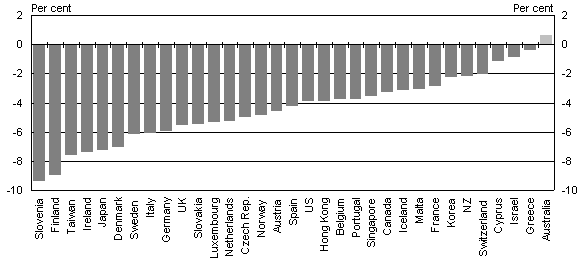
Source: Thomson Reuters.
GDP rose by 0.6 per cent in
the June quarter to be 0.6 per cent higher through the year. The unemployment rate is 5.7 per cent, one of the lowest of the advanced economies.
Chart 2: International unemployment comparison
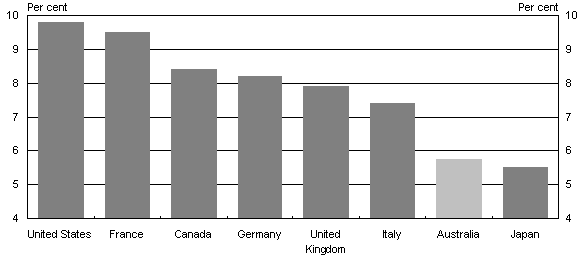
Source: Thomson Reuters.
Inflation is low and is likely to remain so for some time.
Part of this solid performance is due to our sound fundamentals coming into the crisis. Part is due to the early and substantial fiscal and monetary policy response. And part is due to good fortune – particularly our strong resource endowment and our regional ties to China, which has helped offset the drag on the economy from the weak world economy.
I don't want to dwell on the fundaments too much, but let me just mention two key ones.
First, as I mentioned earlier the Australian financial system is in good shape. Four of the world's top nine rated large banks are Australian.
Chart 3: World's 100 largest banking groups by credit rating
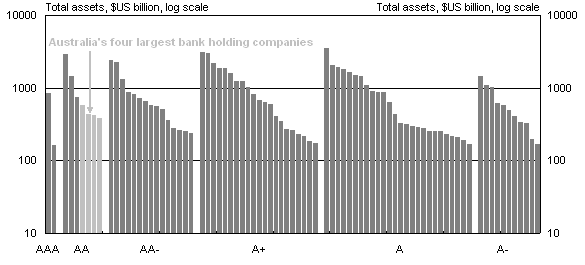
Source: Bloomberg and The Banker.
They are well capitalised and profitable.
Chart 4: Australian major banks' net profits
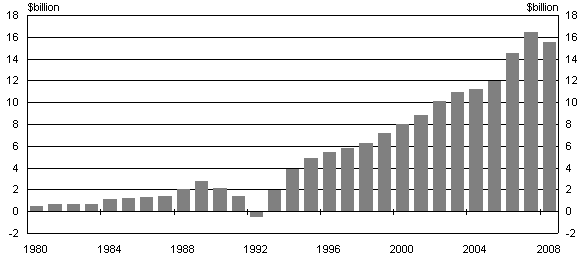
Source: Reserve Bank of Australia.
Second, the Government went into this episode with a willingness to respond swiftly and substantially and because of its strong fiscal position with a capacity to do so.
This backdrop meant that the Government and the Reserve Bank were well positioned to provide substantial support for the economy.
I'll leave it to the Deputy Governor to talk about monetary policy. Let me just acknowledge that we think that the Bank's actions were substantial and well timed, and that they provided good support to the economy when it was needed most.
On fiscal policy, the stimulus has clearly been effective. Retail sales have held up very well, underpinned by the cash payments, the dwelling sector has turned around, supported by the First Home Owners Boost, and sales of cars and other investment goods have clearly benefited from the business investment allowance. The public spending elements of the stimulus are now well underway.
Our estimates are that without the stimulus the economy would have contracted in each of the past three quarters – about 1.3 per cent through the year.
In fact it is possible that the stimulus has been even more effective than we have estimated. The stronger outcomes, and better news from the rest of the world, have boosted consumer and business confidence. Confidence has returned to above pre-crisis levels.
Chart 5: Business and consumer confidence
OECD total
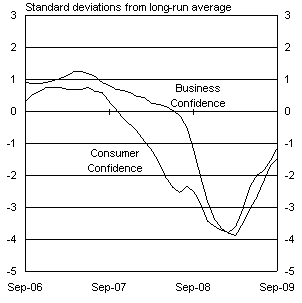
Australia
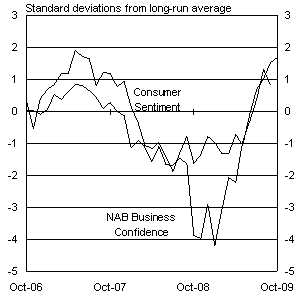
Source: Westpac-Melbourne Institute, National Australia Bank and OECD.
Finally, let me touch on our resource endowment and trade, and particularly trade with China. Australia's trade patterns have changed over the years. Today our top four export markets are China, Japan, South Korea and India. China in particular has become increasingly important. As global trade has fallen away during the global recession, China has bought increasing quantities of our commodity exports. The upshot has been that in a year that the IMF has forecast global trade will fall by nearly 12 percent, Australia's exports have been growing.
Chart 6: Merchandise exports to China vs rest of world
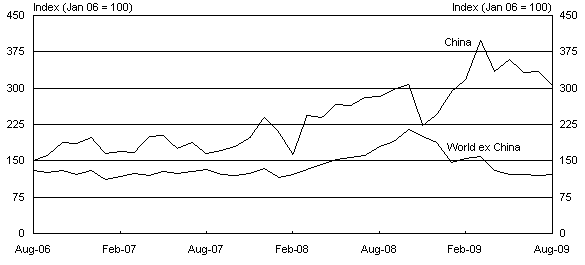
Source: ABS Catalogue Number 5368.0.
The combination of these things has meant the economy has performed better than we expected and the outlook is now substantially brighter than at Budget. We will update our forecasts in the Mid Year Economic and Fiscal Outlook. I am not giving anything away by saying that they will show an improved outlook for growth and employment.
Fiscal Policy
What does this mean for fiscal policy?
The stronger than expected growth has led some people to suggest that the Government should withdraw the stimulus before it has run its full course.
My view is that that policy should always be under review and changes made if necessary, and I think the Treasurer has made this point on a number of occasions.
That said, I can think of several reasons why the economy continues to need support from fiscal policy.
First, even taking on board the better news that we have been hearing lately, and the remaining part of the stimulus, Consensus forecasts still have sluggish GDP growth for some time.
People somehow forget how big the shock has been to the nominal economy. The terms of trade have fallen by nearly 18 per cent over the past three quarters, and profits have continued to fall. The labour market, while holding up well on a heads basis, has seen a sharp fall in hours worked, equivalent to the loss of around 200,000 jobs, which is weighing heavily on labour income. Nominal GDP has fallen in each of the past three quarters. So while things are looking better, we can't get too carried away yet.
Second, on Consensus numbers the output gap – the difference between the potential level of GDP and its currently depressed level – will still hit around 3-4 percent and remain open for several more years. Our best estimates indicate that unemployment will continue to rise well into next year, although clearly not to the heights expected at Budget.
Third, the stimulus is designed to phase out from next year anyway. The peak effects were in the June quarter of this year and by the March quarter next year, the wind down of the stimulus will already be detracting from economic growth.
Chart 7: Withdrawl of stimulus (quarterly)
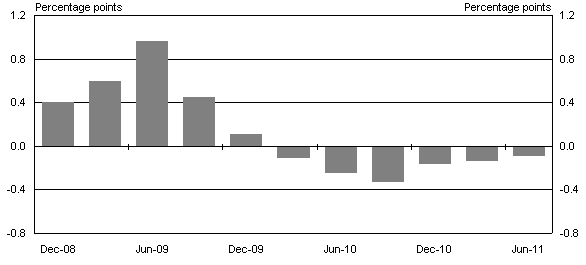
Source: ABS Catalogue Number 5206.0 and Treasury.
Fourth, if we were to withdraw the stimulus faster than this – so that it had no effect in 2010-11 – it would detract a further 1½ per cent from growth. Although things are looking stronger it is hard to believe that private sector demand will be so strong next year that the economy could handle this sort of a hit.
And finally while the world outlook is looking brighter, a solid recovery is still not assured. Last month's labour market report showed that 263,000 jobs were lost in the US in August. While this is 'better than it was' we still have the bar set very low.
Going forward fiscal policy will be guided by the natural unwind of the automatic stabilisers and the planned unwind of the discretionary spending, and by the Government's medium term commitments on tax and spending under i
ts medium term fiscal framework.
The stronger economic outlook will eventually translate into increased revenues and the automatic stabilisers will start to unwind. And as I mentioned earlier the discretionary part of fiscal policy is already starting to unwind.
As the economy strengthens the Government has committed to:
- allow revenues to recover naturally, while keeping tax revenues on average no more than (2007-08) levels; and
- holding growth in real spending to 2 per cent per year once the economy starts growing above trend, until the budget returns to surplus.
Over time, as the economy strengthens adherence to these rules will see the budget return to surplus and debt fall. Of course this type of spending restraint will not be easy, but it has been done in the past and the Government is committed to it.
Consistent with these constraints the Budget forecasts show the budget deficit will be 4.9 per cent of GDP in 2009-10. It is projected to fall over the next several years and eventually return to surplus in 2015-16.
Chart 8: Underlying cash balance projected to 2019-20
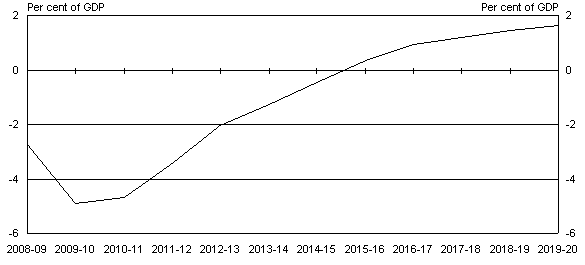
Source: Treasury projections.
Even at its peak, Australia will continue to have much lower levels of debt than other advanced countries.
Chart 9: Government net debt positions for selected countries
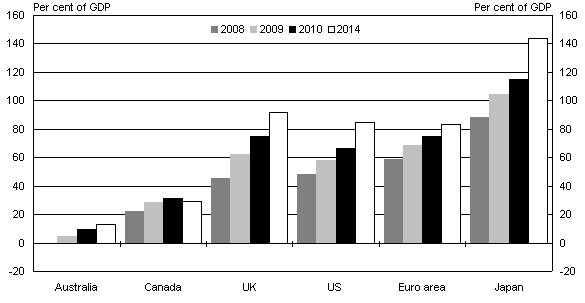
Source: Treasury projections.
The better than expected economic outcomes will obviously have implications for the budget forecasts at MYEFO, although we should get too carried away: a recovery in revenues will take some time to flow through.
The Longer Term
Before I finish let me make a few comments about our longer-term prospects. It's easy to get caught up in the cyclical story at times like these, but it's the structural story that's really important when thinking about the capacity of the economy to generate sustainable long-run returns.
Australia's economy has once again proven to be remarkably flexible and resilient. It has continued to grow through the Asian financial crisis, the tech slowdown at the start of the decade and now through the worst global shock since the Great Depression.
The slowdown has been much shallower than elsewhere, so we have largely avoided the skills atrophy and capital erosion that occurs in deeper recessions. Indeed the government's infrastructure investment has seen total investment hold up strongly. Unlike many other countries, we have emerged from the downturn with little, if any, permanent damage to our long-run output potential.
The public balance sheet remains very healthy and the financial system remains sound. Our institutions and regulatory frameworks have held up well.
We are fortunate to be the positioned in the fastest growing region in the world. The IMF forecasts the Asian region to grow by over 6 per cent this year, not a bad outcome in the midst of a deep global recession.
Our resource endowment is second to none. Australia has the world's largest resources of brown coal, lead, mineral sands, nickel, uranium and zinc. Australia is the largest producer of bauxite, and mineral sands. It is also one of the largest producers of uranium, iron ore, lead, zinc and nickel. We have large reserves of LNG. And we have companies lining up to invest.
Clearly we are in a good position once the cycle moves on.
With all these good prospects it would be easy to become complacent, but we are not. The past year has shown how quickly things can change. Another shock will inevitably come along and we will need to be well prepared for it.